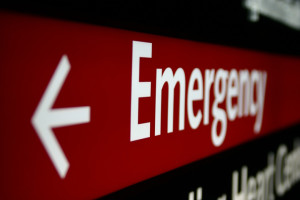Ray Parlett, as the director of campus safety and security, has to deal with emergencies before they happen.
Parlett defined an emergency as “anything that has the potential to cause a threat to life or property or disrupt our operations” in reference to Houghton. Emergencies range from levels one to four, from water leaks and individual injury to major fires and natural disaster. He writes the emergency plan which is the reference for how to approach these emergencies as they come.
 Parlett wrote his first emergency plan in 1999, and “essentially rewrote it” in 2008, in large part because of the emphasis on specific individuals instead of general positions. As people moved on, references to specific names were no longer applicable. To resolve this, a general contact page was created, listing the positions, the corresponding individuals, and their information. “As we have transitions, we can change that page,” Parlett explained.
Parlett wrote his first emergency plan in 1999, and “essentially rewrote it” in 2008, in large part because of the emphasis on specific individuals instead of general positions. As people moved on, references to specific names were no longer applicable. To resolve this, a general contact page was created, listing the positions, the corresponding individuals, and their information. “As we have transitions, we can change that page,” Parlett explained.
This idea of a general framework in fact applies to the entire philosophy of the emergency plan. In considering emergencies, Parlett explained that a lot of what goes into creating an emergency plan is “identifying key players in general types of issues.” This is logical, because as Parlett put it, “they are the ones dealing with it.”
He further noted that “the critical part of that is having the right people in the right place.”
Essentially knowing who to call and where to gather is so important because not every scenario can be predicted. “There is no plan that has every possible contingency,” Parlett explained. If you tried to anticipate every way a situation could go, “the plan would be so cumbersome you would not remember it.” It would be an “impractical reference.”
Parlett’s emphasis on generalities comes from his understanding of emergencies. “Emergency by nature is fluid, fluctuating all the time,” he said. He noted, with a smile, that you cannot expect an emergency to go “as planned.” How, then, are they to be dealt with? Parlett identified flexibility as “absolutely critical,” and further noted drills as an effective way to practice it. “That is the value of doing a drill. It forces you to exercise flexibility and recognize how necessary flexibility really is.”
This was demonstrated in a Gillette fire drill two years ago. The planned situation was meant to replicate a major fire, and while the drill was going on, one of the key people involved had an asthma attack. “It demonstrated that even in an orchestrated situation things didn’t go as planned,” Parlett said. Those dealing with the “emergency” had to adapt to the situation as it came.
Training, then, is an essential aspect of emergency preparedness. Accordingly, the most recent revisions to the emergency plan have come from the “education perspective.” Faculty and staff are being trained to respond to the “more catastrophic” emergencies, when they would need to “take charge.”
Parlett noted that students and faculty the have the chance to be informed as quickly as possible. He encourages students to sign up for WENS, the wireless emergency notification system. Through this they can be notified of an emergency occurring by email or text. Students can sign up online through a student portal, and faculty through a faculty portal. An email will soon be sent out with more specifics about WENS. Students and faculty can rest assured, then, that a plan is in place with the appropriate personnel to deal with any emergency and that they will know about it as soon as possible.
